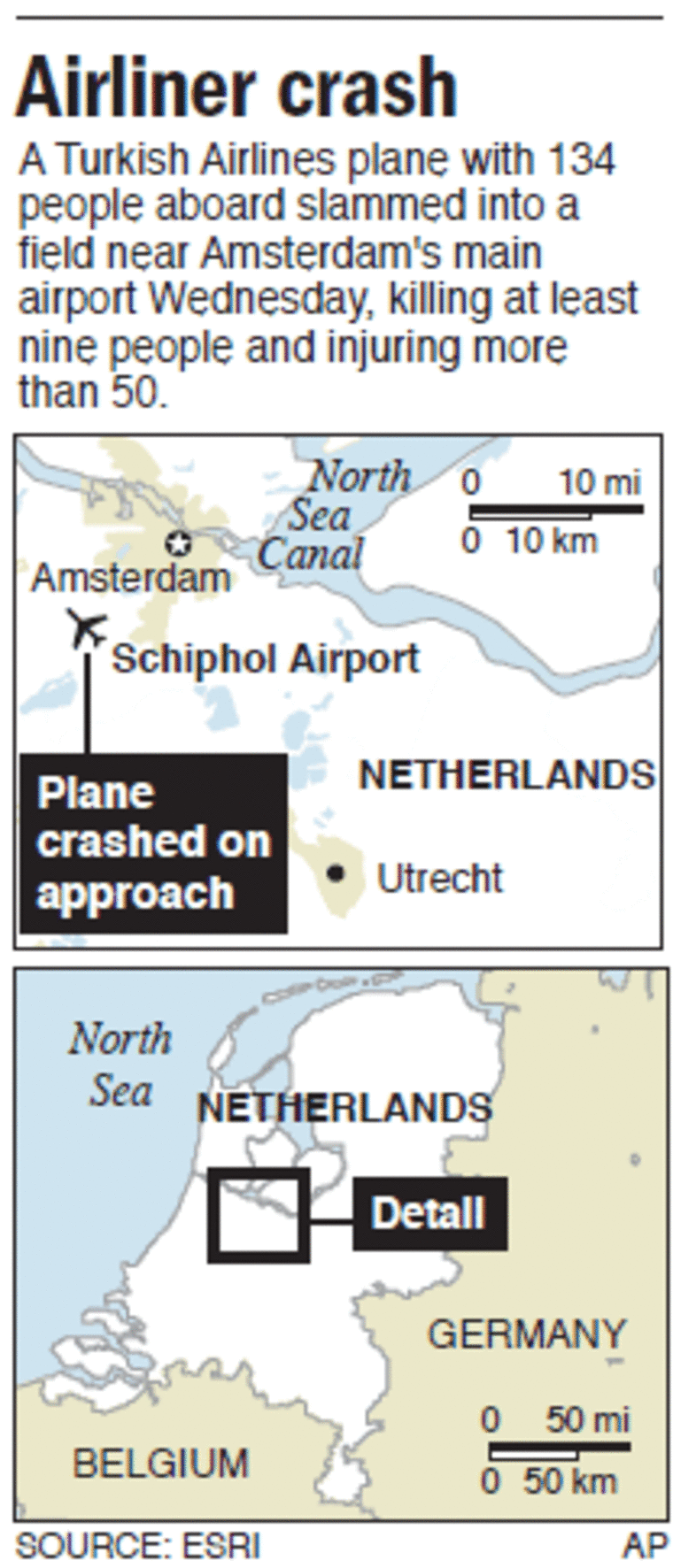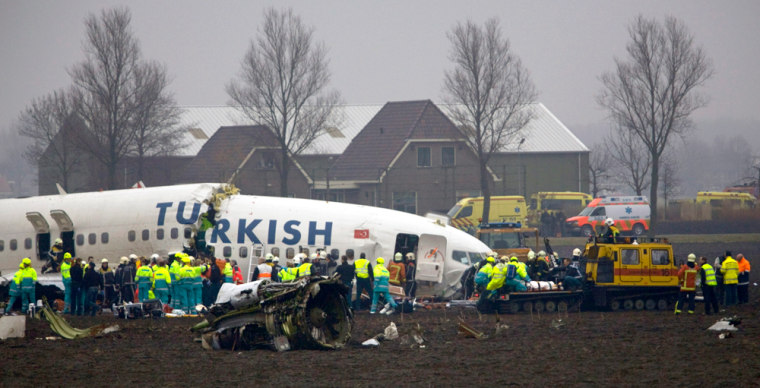A Turkish Airlines jetliner crashed into a muddy field Wednesday while trying to land at Amsterdam's main airport, but 125 of the 134 people on board survived. The nine dead included both pilots.
The Boeing 737-800, en route from Istanbul to Amsterdam, broke into three pieces when it hit the ground about two miles short of a runway at Schiphol Airport at 10:31 a.m. local time. The fuselage split in two, close to the cockpit, and the tail broke off.
But the wreckage didn't burn and scores of people walked away from it.
At first, the airline said everyone survived. But at a news conference later, Michel Bezuijen, acting mayor of Haarlemmermeer, reported the fatalities.
Six of the injured were in critical condition, 25 were seriously hurt and 24 had slight injuries, health authorities said. Survivors were taken to 11 hospitals including an emergency field hospital set up by the military in the central city of Utrecht.
A spokesman for investigators said two pilots and an apprentice pilot were among the dead.
The Turkish ambassador to the Netherlands, Selahattin Alpar, said there were 72 Turks and 32 Dutch citizens on board. There was no information on the nationality of other passengers.
There was no immediate word on the cause of the crash. Weather at the time was cloudy with a slight drizzle.
Pieter van Vollenhoven, head of the Dutch Safety Authority investigating the cause, said it appeared the plane lost speed before crashing.
"You see that because of a lack of speed it literally fell out of the sky," he told NOS radio after visiting the crash site.
'It happened so fast'
Survivor Huseyin Sumer told Turkish NTV television he crawled to safety out of a crack in the fuselage.
"We were about to land, we could not understand what was happening, some passengers screamed in panic but it happened so fast," Sumer said. He said the crash was over in five to 10 seconds.
Another survivor, Jihad Alariachi, said there was no warning from the cockpit to brace for landing before the ground loomed up through the mist and drizzle.
"We braked really hard, but that's normal in a landing. And then the nose went up. And then we bounced ... with the nose aloft," she said, adding that she and her sister scrambled out an emergency exit.
Turkish Transport Minister Binali Yildirim said it was "a miracle" there were not more casualties.
"The fact that the plane landed on a soft surface and that there was no fire helped keep the number of fatalities low," he said.
Authorities said the mud may have lessened the impact and helped avert a fire from breaking out in the ruptured fuel tanks and lines on the underside of the fuselage.
In addition, having reached its destination, the plane would have used up most of its fuel, lessening the chances of a fuel-driven fire.
Authorities would not say whether the plane sent out a distress call before the crash.
Data recorders foundHours after the crash, authorities said they found the plane's flight data recorders.
The recording equipment, which could give an indication of what happened in the minutes leading to the crash, will be sent to Paris for analysis, said Fred Sanders of the Dutch Safety Board.
The plane, Flight TK1951, left Istanbul's Ataturk Airport at 8:22 a.m. (1:22 a.m. ET) bound for Amsterdam.
Candan Karlitekin, the head of the airline's board of directors, told reporters in Turkey that visibility was good at the time of landing.
"Visibility was clear and around 5,000 yards. Some 550 yards before landing; the plane landed on a field instead of the runway," he said.
"We have checked the plane's documents and there is no problem concerning maintenance," he added.
Turkish Airlines CEO Temel Kotil said the captain, Hasan Tahsin, was a former air force pilot and was very experienced.
Turkish officials said the plane was built in 2002 and last underwent maintenance on Dec. 22.
Turkish Airlines has had several serious crashes since 1974, when 360 people died when a DC-10 crashed near Paris when a cargo door came off. More recently, in 2003, 75 died when an RJ-100 missed the runway in heavy fog in the southeastern Turkish city of Diyarbakir.
'Very good' 737 safety record
Four Boeing employees traveling on business were aboard the plane, according to Jim Proulx, a spokesman for the company. All four are based in the Seattle area, he said, but he would not provide further details until their families had been notified.
He said Boeing was sending a team to provide technical assistance to Dutch safety officials as they investigate. The plane's flight data recorders were recovered and were to be analyzed by experts.

Boeing's 737 is the world's best-selling commercial jet, with more than 6,000 orders since the model was launched in 1965.
The 737-800, a recent version of the plane, has a "very good safety record," said Bill Voss, president of the independent Flight Safety Foundation in Alexandria, Va. "It has been involved in a couple of accidents, but nothing that relates directly back to the aircraft," he said.
Gideon Evers, spokesman of the International Federation of Airline Pilots Associations, said there was no indication that the crash had anything to do with fuel levels. He said that regulations require all commercial flights to carry ample reserves.
"Certainly it appears to be an unusual circumstance, but as always the sensible course of action is to wait for the results of the investigation," he said.
Wim Kok, a spokesman for the Dutch Anti-Terror Coordinator's office, said terrorism did not appear to be a factor. "There are no indications whatsoever" of a terror attack," Kok said.
In Washington, the National Transportation Safety Board said it was sending a team to Amsterdam to help with the investigation.
